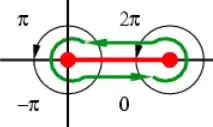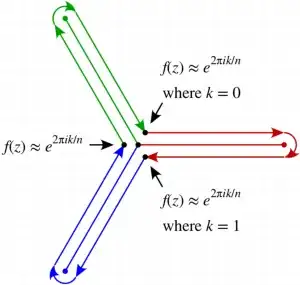$\newcommand{\angles}[1]{\left\langle\, #1 \,\right\rangle}
\newcommand{\braces}[1]{\left\lbrace\, #1 \,\right\rbrace}
\newcommand{\bracks}[1]{\left\lbrack\, #1 \,\right\rbrack}
\newcommand{\ceil}[1]{\,\left\lceil\, #1 \,\right\rceil\,}
\newcommand{\dd}{{\rm d}}
\newcommand{\ds}[1]{\displaystyle{#1}}
\newcommand{\expo}[1]{\,{\rm e}^{#1}\,}
\newcommand{\fermi}{\,{\rm f}}
\newcommand{\floor}[1]{\,\left\lfloor #1 \right\rfloor\,}
\newcommand{\half}{{1 \over 2}}
\newcommand{\ic}{{\rm i}}
\newcommand{\iff}{\Longleftrightarrow}
\newcommand{\imp}{\Longrightarrow}
\newcommand{\pars}[1]{\left(\, #1 \,\right)}
\newcommand{\partiald}[3][]{\frac{\partial^{#1} #2}{\partial #3^{#1}}}
\newcommand{\pp}{{\cal P}}
\newcommand{\root}[2][]{\,\sqrt[#1]{\vphantom{\large A}\,#2\,}\,}
\newcommand{\sech}{\,{\rm sech}}
\newcommand{\sgn}{\,{\rm sgn}}
\newcommand{\totald}[3][]{\frac{{\rm d}^{#1} #2}{{\rm d} #3^{#1}}}
\newcommand{\verts}[1]{\left\vert\, #1 \,\right\vert}$
\begin{align}&
\overbrace{\color{#c00000}{\int_{0}^{1}{\dd x \over \root[n]{1 - x^{n}}}\dd x}}
^{\ds{x^{n}\ \mapsto\ x}}\ =\
\int_{0}^{1}\pars{1 - x}^{-1/n}\,{1 \over n}\,x^{1/n - 1}\,\dd x
={1 \over n}\color{#00f}{\int_{0}^{1}x^{1/n - 1}\pars{1 - x}^{-1/n}\,\dd x}
\,\,\,\,\,\pars{1}
\end{align}
Now, we study the integral
$$
\oint_{\rm DB}{z^{1/n}\pars{1 - z}^{-1/n} \over z}\,\dd z
$$
where $\ds{\rm DB}$ is a "dumbbell contour" ( see picture ). 
Also,
$$
\begin{array}{rclrcccl}
z^{1/n} & = & \verts{z}^{1/n}\expo{{\rm Arg}\pars{z}/n}\,,
& -\pi & < & {\rm Arg}\pars{z} & < & \pi\,,\quad z \not= 0
\\[2mm]
\pars{1 - z}^{-1/n} & = & \verts{1 - z}^{-1/n}\expo{-{\rm Arg}\pars{1 - z}/n}\,,
& 0 & < & {\rm Arg}\pars{1 - z} & < & 2\pi\,,\quad z \not= 1
\end{array}
$$
It's clear that the product $\ds{z^{1/n}\pars{1 - z}^{-1/n}}$ has a branch-cut
in $\bracks{0,1}$.
The integral above the "upper line' is given by
$$
\int_{1}^{0}x^{1/n - 1}\pars{1 - x}^{-1/n}\expo{-2\pi\ic/n}\,\dd x
=
-\expo{-2\pi\ic/n}\color{#00f}{\int_{0}^{1}x^{1/n}\pars{1 - x}^{-1/n}\,\dd x}
$$
and in the "lower line" by
$\ds{\color{#00f}{\int_{0}^{1}x^{1/n}\pars{1 - x}^{-1/n}\,\dd x}}$. Integration around the semicircles, with centers at $\ds{z = 0}$ and $\ds{z = 1}$, vanishes out when their radius $\ds{\to 0^{+}}$.
Then,
\begin{align}
&\pars{1 - \expo{-2\pi\ic/n}}\color{#00f}{%
\int_{0}^{1}x^{1/n - 1}\pars{1 - x}^{-1/n}\,\dd x}
=-2\pi\ic\,
{\rm Res}_{\verts{z}\ \to\ \infty}\bracks{z^{1/n - 1}\pars{1 - z}^{-1/n}}
\\[3mm]&=-2\pi\ic\,{\rm Res}_{z\ =\ 0}\bracks{%
-\,{1 \over z^{2}}\,z^{1 - 1/n}\pars{1 - {1 \over z}}^{-1/n}}
=2\pi\ic\,{\rm Res}_{z\ =\ 0}\bracks{\pars{z - 1}^{-1/n} \over z}
\\[3mm]&=2\pi\ic\,
{\rm Res}_{z\ =\ 0}\bracks{\verts{z - 1}^{\,-1/n}\expo{-\pi\ic/n} \over z}
=2\pi\ic\expo{-\pi\ic/n}
\end{align}
Then
$$
\color{#00f}{\int_{0}^{1}x^{1/n - 1}\pars{1 - x}^{-1/n}\,\dd x}
={2\pi\ic\expo{-\pi\ic/n} \over 1 - \expo{-2\pi\ic/n}}
=\pi\,{2\ic \over \expo{\pi\ic/n} - \expo{-\pi\ic/n}}
={\pi \over \sin\pars{\pi/n}}
$$
which is replaced in expression $\pars{1}$:
$$
\color{#00f}{\large\int_{0}^{1}{\dd x \over \root[n]{1 - x^{n}}}\dd x
={\pi \over n\sin\pars{\pi/n}}}
$$

